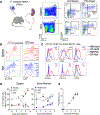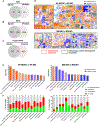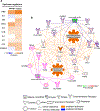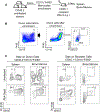Integrative analysis of microRNA and mRNA expression profiles of monocyte-derived dendritic cells differentiation during experimental cerebral malaria
- PMID: 32362022
- PMCID: PMC11215656
- DOI: 10.1002/JLB.1MA0320-731R
Integrative analysis of microRNA and mRNA expression profiles of monocyte-derived dendritic cells differentiation during experimental cerebral malaria
Abstract
Heterogeneity and high plasticity are common features of cells from the mononuclear phagocyte system: monocytes (MOs), macrophages, and dendritic cells (DCs). Upon activation by microbial agents, MO can differentiate into MO-derived DCs (MODCs). In previous work, we have shown that during acute infection with Plasmodium berghei ANKA (PbA), MODCs become, transiently, the main CD11b+ myeloid population in the spleen (SP) and once recruited to the brain play an important role in the development of experimental cerebral malaria (ECM). Here, we isolated 4 cell populations: bone marrow (BM) MOs (BM-MOs) and SP-MOs from uninfected mice; BM inflammatory MOs (BM-iMOs) and SP-MODCs from PbA-infected mice and used a system biology approach to a holistic transcriptomic comparison and provide an interactome analysis by integrating differentially expressed miRNAs (DEMs) and their differentially expressed gene targets (DEGs) data. The Jaccard index (JI) was used for gauging the similarity and diversity among these cell populations. Whereas BM-MOs, BM-iMOs, and SP-MOs presented high similarity of DEGs, SP-MODCs distinguished by showing a greater number of DEGs. Moreover, functional analysis identified an enrichment in canonical pathways, such as DC maturation, neuroinflammation, and IFN signaling. Upstream regulator analysis identified IFNγ as the potential upstream molecule that can explain the observed DEMs-Target DEGs intersections in SP-MODCs. Finally, directed target analysis and in vivo/ex vivo assays indicate that SP-MODCs differentiate in the SP and IFNγ is a main driver of this process.
Keywords: MODC; Plasmodium; cell differentiation; miRNA; systems biology.
©2020 Society for Leukocyte Biology.
Conflict of interest statement
DISCLOSURES
The authors declare no conflicts of interest.
Figures






References
-
- Le Borgne M, Etchart N, Goubier A, et al. Dendritic cells rapidly recruited into epithelial tissues via CCR6/CCL20 are responsible for CD8+ T cell crosspriming in vivo. Immunity. 2006;24(2):191–201. - PubMed
-
- Lai SM, Sheng J, Gupta P, et al. Organ-specific fate, recruitment, and refilling dynamics of tissue-resident macrophages during blood-stage malaria. Cell Rep. 2018;25(11):3099–3109. - PubMed

